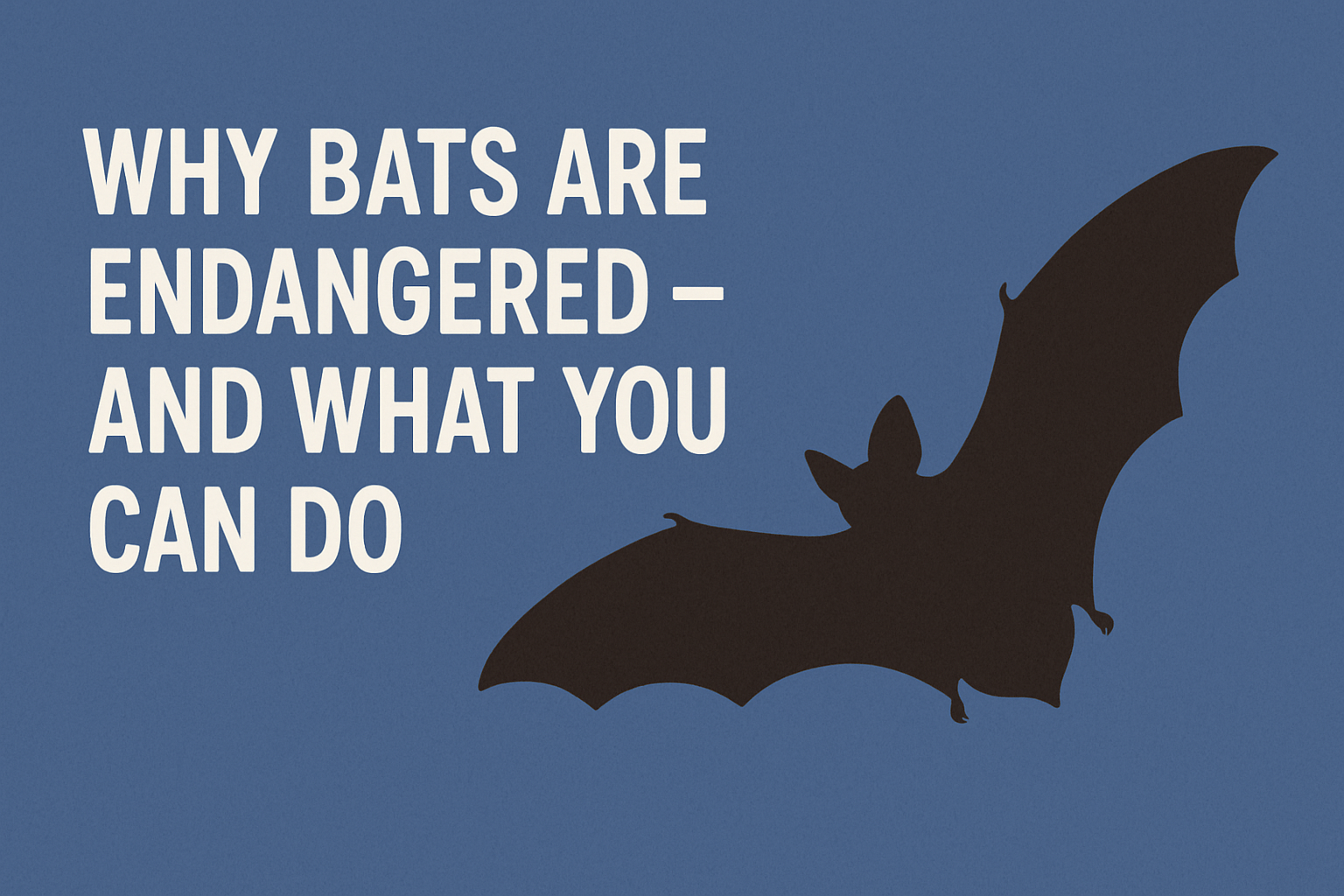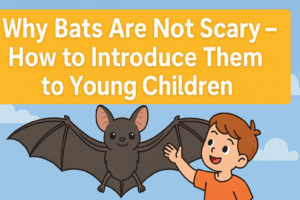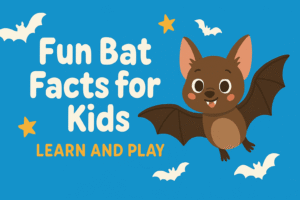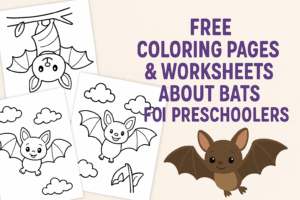Let’s face it:
Bats don’t have the best PR team.
They’ve been cast as the villains in horror flicks, Halloween décor, and urban legends for decades. But the truth? Bats are incredibly important—and dangerously overlooked.
Right now, bat populations are declining worldwide, and many species are on the edge of extinction.
But here’s the good news: you can help, and it’s easier than you think.
In this guide, we’ll break down:
- Why bats are endangered
- What’s really causing their decline
- And what you (yes, you!) can do to help save them
Grab a mug of something cozy, and let’s talk about saving the unsung heroes of the night sky.
Why Are Bats Endangered?
Let’s start with the basics: bats aren’t just in trouble.
They’re in real danger—and the reasons might surprise you.
1. White-Nose Syndrome (WNS)
This deadly fungal disease has wiped out millions of bats in North America since it was discovered in 2006.
What is it?
WNS is caused by a cold-loving fungus (Pseudogymnoascus destructans) that attacks hibernating bats, growing on their faces and wings. It wakes them up during hibernation, draining their energy reserves and often leading to death by starvation or freezing.
Impact:
- Some bat colonies have lost over 90% of their population
- Little brown bats, once the most common bat in the U.S., are now at risk
- WNS continues to spread across states and borders
There is no known cure yet, but scientists and conservationists are working hard on it.
2. Habitat Loss and Fragmentation
Bats need places to roost, hibernate, and raise their pups. These include:
- Caves
- Hollow trees
- Old barns
- Forests
- Even under bridges
But urban development, deforestation, agriculture, and logging are destroying or fragmenting those spaces.
Less habitat = fewer bats.
It’s that simple.
3. Light Pollution and Disturbance
Bats are nocturnal. They thrive in the dark.
But our modern world is lit up 24/7.
Bright lights can:
- Disrupt their feeding and hunting routines
- Push them away from roosting areas
- Disorient migratory species
And when humans explore caves or disturb roosts (especially during hibernation)?
It can literally cause bats to die from being woken up too early.
4. Pesticides and Pollution
Many bats eat insects—especially mosquitoes, moths, and beetles. But when those bugs are covered in chemical pesticides, bats ingest toxins too.
Over time, this can:
- Affect their reproductive health
- Weaken immune systems
- Lead to slow population decline
Pollution in water sources and soil doesn’t help either. Bats drink from ponds, lakes, and puddles, just like other wildlife.
5. Fear, Misunderstanding, and Misinformation
Let’s be real—bats get a bad rap.
And it’s killing them.
People destroy roosts out of fear.
They seal up attics full of bats in summer, trapping pups inside.
They assume all bats have rabies (spoiler: less than 1% do).
This fear leads to intentional harm, even when bats are federally protected.
Why It Matters (To You, Not Just Nature)
Still not sure why you should care? Let’s put it this way:
Without bats, we’d face:
- Exploding insect populations (hello, mosquito armageddon)
- More pesticide use (bad for bees, humans, pets… everyone)
- Lower crop yields (aka more expensive food)
- Loss of pollination for key plants (bye-bye, bananas and agave)
- Unbalanced ecosystems that spiral into chaos
Bats are like the gears in a giant ecological machine—take them out, and everything starts grinding down.
What You Can Do to Help Save Bats
The situation might sound scary (because it is), but the truth is, you don’t need to be a scientist or wildlife expert to help.
Here are 10 things you can do right now to support bat conservation in your community:
1. Build or Install a Bat House
Give bats a safe place to roost that’s not your attic.
Bat houses provide shelter for maternity colonies and displaced bats.
Tips:
- Mount 12–20 feet high
- Face south or southeast for sunlight
- Avoid shady, tree-covered areas
- Place near water if possible
Not handy? You can buy one pre-made online or support a local wildlife group that builds them!
2. Plant a Bat-Friendly Garden
No, bats don’t eat flowers—but they do eat the insects those plants attract.
What to plant:
- Night-blooming flowers (like moonflower or evening primrose)
- Native plants that support moths and beetles
- Herbs like mint, basil, and lavender
A healthy bug population = a healthy bat buffet.
3. Reduce Light Pollution
Too much light = bat flight disruption.
What to do:
- Turn off unnecessary outdoor lights
- Use motion sensors instead of floodlights
- Choose warm-toned, low-wattage bulbs
- Encourage your community to go “Dark Sky” friendly
4. Ditch the Pesticides
Pesticides hurt bugs and the animals that eat them—like bats.
Try:
- Natural pest control (ladybugs, neem oil, essential oils)
- Companion planting
- Mulching with organic materials
- Letting bats be your pest control crew!
5. Educate Your Friends & Family
Change starts with a conversation.
Tell people:
- Bats are pollinators and pest controllers
- Most are harmless, gentle creatures
- Killing or disturbing bats is often illegal and unethical
The more people know, the more people care.
6. Protect Local Roosts
Know of a cave or abandoned barn with bats?
Leave it alone—or talk to wildlife experts before disturbing it.
If you have bats in your attic:
- Wait until fall or early spring
- Call a humane wildlife exclusion expert
- Install a bat house nearby so they have a new home
7. Keep Water Clean and Accessible
A simple birdbath, pond, or rain barrel can be a bat life-saver—especially in the summer.
Make sure it’s:
- Cleaned regularly
- Not full of chemicals or pesticides
- Shallow and safe for wildlife
8. Support Bat Conservation Organizations
Every little bit helps.
Consider donating to or volunteering with:
- Bat Conservation International
- The Bat Conservation Trust
- Ohio Bat Working Group (if you’re local!)
- Your local wildlife rehab center
They’re the boots on the ground fighting for bat survival.
9. Join or Host a Bat House Building Event
Perfect for:
- Classrooms
- Scouts
- Community groups
- Nature clubs
It’s fun, educational, and super rewarding. Bonus: your neighborhood gets actual bat houses out of it.
10. Celebrate Bats, Don’t Fear Them
Go to a bat walk.
Join the Ohio Bat Festival.
Post bat facts on Instagram.
Dress as a bat for Halloween—instead of a vampire.
Shift the narrative from scary to spectacular.
Final Thoughts: Bats Deserve a Fighting Chance
They don’t ask for much.
A place to roost. A few bugs to eat. A little darkness. A little respect.
And in return?
They give us cleaner air, fewer mosquitoes, thriving crops, and balanced ecosystems. Every. Single. Night.
So let’s stop the myths.
Let’s flip the narrative.
Let’s save the bats—because they’ve been saving us all along.
Want help building your first bat house? Curious about native bat species near you? Drop a comment—I’m always down for a bat chat.




